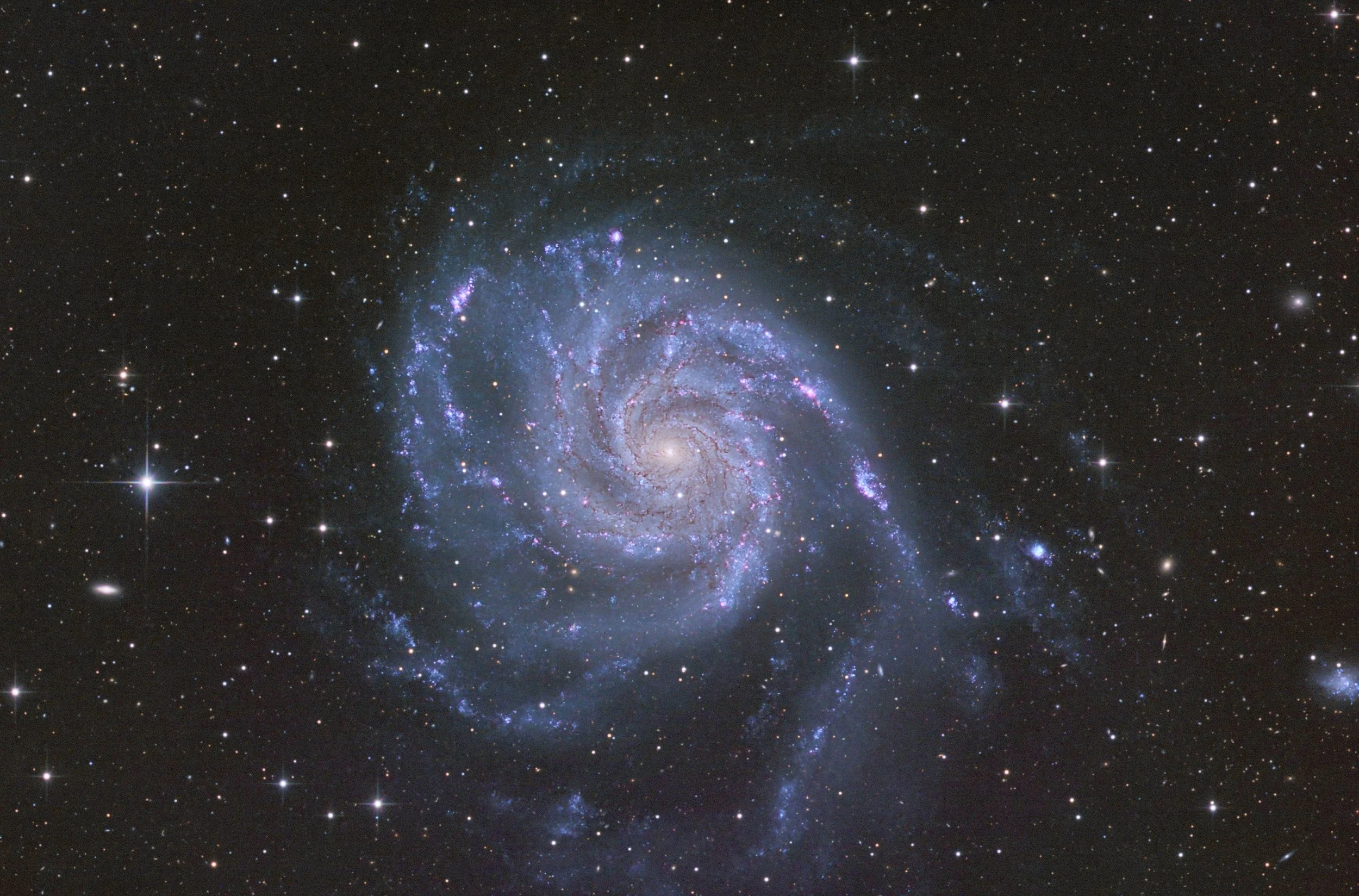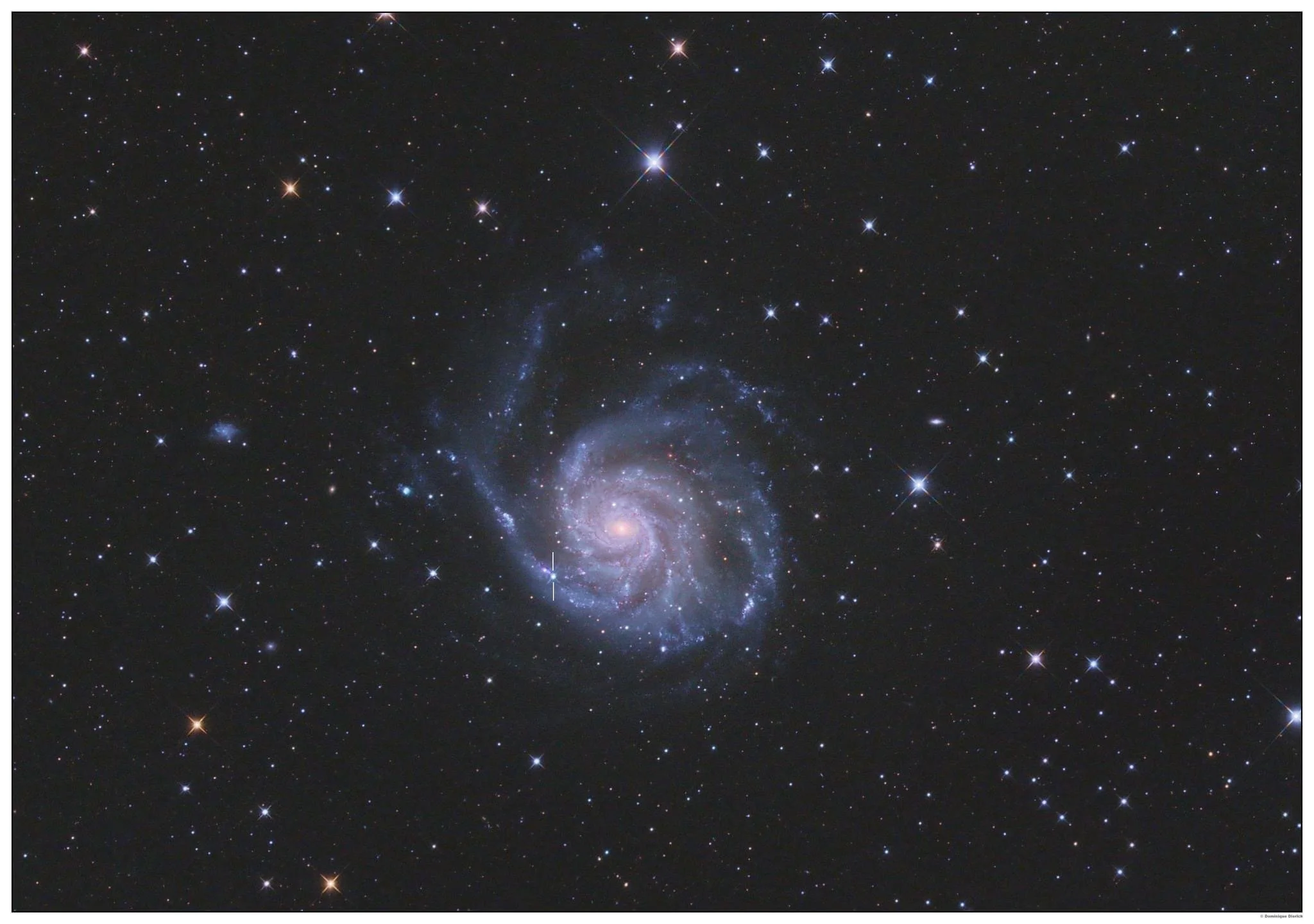
AAPOD2 Image Archives
M101 in LRGB
Messier 101 (M101), also known as the Pinwheel Galaxy, is a grand-design spiral galaxy located approximately 21 million light-years away in the constellation Ursa Major. With a diameter of about 170,000 light-years, it is nearly twice the size of the Milky Way. M101's well-defined spiral arms are rich in star-forming regions, evidenced by the numerous HII regions that dot its structure. These regions are massive clouds of hydrogen gas that glow brightly due to the ionizing radiation from young, hot stars within them.
An interesting aspect of M101 is its asymmetrical shape, which is likely the result of gravitational interactions with its neighboring galaxies. This interaction has caused a distortion in its spiral arms, making them appear uneven. Additionally, M101 has a high surface brightness, making it a favorite target for amateur astronomers. Despite its beauty and prominence, M101's distance from Earth means that observing its finer details requires a telescope with good resolution and light-gathering capabilities.
M101
M101, also known as the Pinwheel Galaxy, is a majestic spiral galaxy located in the constellation Ursa Major. Situated about 21 million light-years away from Earth, M101 is one of the largest and brightest spiral galaxies in the sky, spanning approximately 170,000 light-years in diameter. Its spiral arms are adorned with clusters of young, hot stars, bright nebulae, and dark lanes of interstellar dust, creating a captivating tapestry of celestial beauty.
This stunning galaxy has been the subject of numerous astronomical studies due to its proximity and striking appearance. It hosts a high rate of supernova activity, making it an excellent laboratory for studying stellar evolution and galaxy dynamics. M101 offers astronomers valuable insights into the formation and evolution of spiral galaxies, enriching our understanding of the cosmos.
The Nova and Friends
Scientists and astrophotgraphers around the world were captivated by the awe-inspiring spectacle of a recent supernova in the magnificent spiral galaxy, M101, also known as the Pinwheel Galaxy. The brilliant explosion occurred in a distant corner of the galaxy, illuminating the cosmic stage with a dazzling display of celestial fireworks.
This cataclysmic event unleashed an incredible amount of energy, as the massive star met its dramatic end, releasing shockwaves and dispersing heavy elements into the vastness of space. Observations and measurements from various telescopes and instruments have provided invaluable insights into the dynamics and aftermath of this breathtaking supernova, contributing to our ever-expanding knowledge of stellar evolution and the extraordinary forces that shape our universe.
M101 supernova
Cropped image of M101 image of last night, with bright supernova 2023ixf (discovered in Japan on May 19th). The supernova is indicated between two line segments. The sky was not really good, with high thin clouds present during the 2 hour exposure with Takahashi Epsilon 160ED.
Copyright: Dominique Dierick
M 101 - Pinwheel Galaxy
Image Description and Details : The Pinwheel Galaxy (also known as Messier 101, M101 or NGC 5457) is a face-on spiral galaxy distanced 21 million light-years (six megaparsecs) away from Earth in the constellation Ursa Major. Discovered by Pierre Méchain on March 27, 1781, it was communicated to Charles Messier who verified its position for inclusion in the Messier Catalogue as one of its final entries.
M101 is a large galaxy, with a diameter of 170,000 light-years. By comparison, the Milky Way has a diameter of 100,000 light years. It has around a trillion stars, a little more than twice the number in the Milky Way. It has a disk mass on the order of 100 billion solar masses, along with a small central bulge of about 3 billion solar masses.
M101 has a high population of H II regions, many of which are very large and bright. H II regions usually accompany the enormous clouds of high density molecular hydrogen gas contracting under their own gravitational force where stars form. H II regions are ionized by large numbers of extremely bright and hot young stars; those in M101 are capable of creating hot super-bubbles.
M101 is asymmetrical due to the tidal forces from interactions with its companion galaxies. These gravitational interactions compress interstellar hydrogen gas, which then triggers strong star formation activity in M101's spiral arms that can be detected in ultraviolet images.
Imaging telescopes or lenses: Takahashi FSQ130ED
Imaging cameras: QSI 6120i
Mounts: Takahashi EM 400 Temma 2M
Guiding telescopes or lenses: Takahashi FS60CB
Guiding cameras: QHY CCD QHY 5 II
Focal Extender / Reducer: None
Software: Sequence Generator Pro SGP (for capture) PHD 2 (guiding), Astro Pixel Processor & PixInsight,
Filters: Astrodon LRGB Astrodon Ha (3nm)
Dates: 3rd Mar 2019 - 8th Mar 2019 AND 22nd March 2023
Copyright: Brendan Kinch






